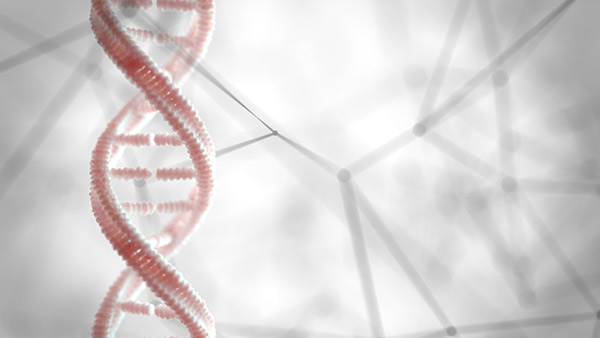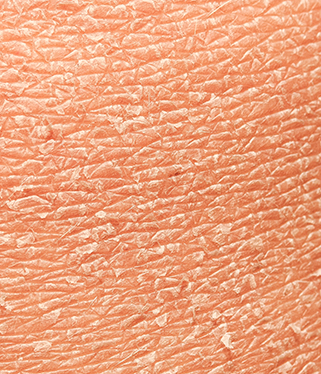Dry skin can be caused by a lack of the essential protein filaggrin in the skin. But why do some people have filaggrin deficiency, how widespread is the problem, and can it be alleviated?
This article is based on an interview with Professor of Dermatology, Torkil Menné.
Filaggrin is a protein that occurs naturally in the skin. It plays a vital role in keeping the skin sufficiently hydrated and thus a lack of filaggrin can lead to dry and cracked skin. Here you can read about why some people have filaggrin deficiency, how widespread the problem is, and how to alleviate skin disorders that occur as a result of filaggrin deficiency.
Filaggrin is an abbreviation of filament aggregating protein.1 The name derives from the special ability that filaggrin has to bind other molecules together. Filaggrin deficiency is a more widespread problem than was once thought. Approximately 9% of Northern Europeans carry a mutation in one of the DNA strands of the gene that codes for filaggrin production. A smaller proportion have mutations in both of these DNA strands and these people typically exhibit more severe and prolonged clinical symptoms.
Furthermore, up to 50% of all people with atopic dermatitis have filaggrin deficiency. While environmental factors may play a role in the development of atopic dermatitis, if a person suffers from filaggrin deficiency, the risk of developing atopic dermatitis is greatly increased.2

Causes of filaggrin deficiency in the skin
There are two primary causes of filaggrin deficiency: The deficiency may be due to the aforementioned genetic defect, but filaggrin deficiency can also arise because the skin inflammation associated with, e.g., atopic dermatitis, psoriasis and, in all probability, Sjögren’s syndrome cause a reduction in the natural production of filaggrin and the enzyme which breaks down filaggrin into amino acids. In both cases, filaggrin deficiency will lead to dry, fragile and sensitive skin that requires extra care.
Filaggrin deficiency can cause dry and scaly skin
If you lack filaggrin in your skin, the regular application of ordinary moisturizing creams will have little effect. Because in the absence of filaggrin, the skin has difficulty binding water and, therefore, becomes dry and cracked. Thus, filaggrin deficiency can lead to dry spots and cracks in the skin as well as dry and scaly skin on the arms and legs. This condition is called ichthyosis vulgaris or “fish scale” disease.
Amino acids restore balance to the skin
The normal pH value of the skin lies between 5.5 and 6 but in cases of filaggrin deficiency, pH is increased 2 such that the skin lacks a normal acid-base balance.
Filaggrin plays an important role in ensuring that the skin’s natural moisturizing factor (also known as NMF) functions as it should. A properly functioning natural moisturizing factor (NMF) contains water-binding substances lying alongside the fats in the skin. These water-binding substances are primarily amino acids that come from filaggrin but can also include lactic acid, for example. By adding amino acids that are a natural part of the skin’s properly functioning moisturizing factor (NMF) to skin which is dry due to filaggrin deficiency, one can, thus, restore balance to the skin.
Would you like to learn more?
If you would like to learn more about dry skin and filaggrin deficiency, you can delve into some of the scientific articles listed below.
References and scientific articles on the topic:
-
Ivana Čepelak, Slavica Dodig, Ivan Pavić. Filaggrin and atopic march. Biochem Med (Zagreb) 2019;29(2):020501
-
Thyssen JP, Kezic S. Causes of epidermal filaggrin reduction and their role in the pathogenesis of atopic dermatitis. J Allergy Clin Immunol. 2014;134(4):792-799.
-
Thyssen JP, Godoy-Gijon E, Elias PM. Ichthyosis vulgaris: the filaggrin mutation disease. Br J Dermatol. 2013 Jun;168(6):1155-66
-
McAleer MA, Irvine AD. The multifunctional role of filaggrin in allergic skin disease. J Allergy Clin Immunol. 2013;131(2):280-291.
-
Bernacchi E, Amato L, Parodi A, Cottoni F, Rubegni P, De Pità O, Papini M, Rebora A, Bombardieri S, Fabbri P. Sjögren’s syndrome: a retrospective review of the cutaneous features of 93 patients by the Italian Group of Immunodermatology. Clin Exp Rheumatol. 2004 Jan-Feb;22(1):55-62
-
Kittridge A, Routhouska SB, Korman NJ. Dermatologic manifestations of Sjögren syndrome. J Cutan Med Surg. 2011 Jan-Feb;15(1):8-14. doi: 10.2310/7750.2010.09033. PMID: 21291650.
-
Generali E, Costanzo A, Mainetti C, Selmi C. Cutaneous and Mucosal Manifestations of Sjögren’s Syndrome. Clin Rev Allergy Immunol. 2017 Dec;53(3):357-370

